#enlarging lens
Explore tagged Tumblr posts
Video
Popp Art by simple.joy Via Flickr: Shot with a Tamron "(Noritsu) 48.5 mm F 2.8" (enlarging) lens on a Canon EOS R5.
0 notes
Text
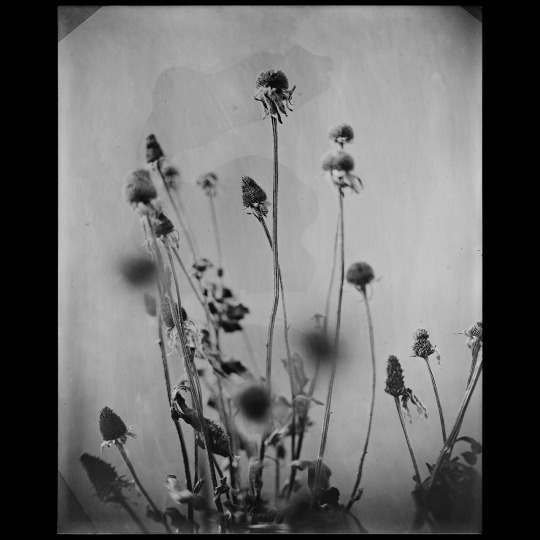
Biological Remnants (Gloriosa Daises) - analog photograph - paper negative, 60- second exposure +/-, hand-built cardboard box camera, wollensak 127mm enlarger lens, caffenol developer - robert matejcek - 2025
“To say goodbye is to die a little.” - Raymond Chandler - The Long Goodbye
tags
#robert matejcek#photography#film photography#analog#paper negative#ilford#large format#caffenol#enlarger lens#wollensak#handmade camera#cardboard box camera#alternative photography#alternative photographic processes#experimental#art#my art#still life#plants#daisies#botanicals#dried flowers#dark academia#dark aesthetic#grunge aesthetic#photographers on tumblr#artists on tumblr
21 notes
·
View notes
Text
This is a great breakdown of phone cameras and worth a read if you do most of your photography with a phone.
Phone cameras are comparable to or better than many point-and-shoot digital cameras (especially older generation cameras, and this has been the case for several years now). But there is no such thing as a "pro" phone camera, just like there's no such thing as a "pro" point-and-shoot.
You can get really great photos and they can absolutely serve your needs. It's a fantastic solution if you're not in a position to carry extra gear with you.
But they are not "pro".
They can also be a perfectly acceptable tool for photography as an art form. You use the tools and explore and maximise their capabilities as you feel driven to. You certainly limit yourself in major ways with a camera phone, but that's part of the art. ALL photography is bound by the limits of your tool, and the entire point is to work within those and push your craft to see what you can do. So you can use the camera phone AS a pro (i.e. someone who understands the tool and principles of photography), but you have to understand the tool for that.
If you want a pro camera though, get a real camera.
Also, you need to identify the type of photography you like or want to do in order to choose the right camera.
I do a LOT of handheld, low-light photography w/o flash (museums, early or late hiking, etc.) so the sacrifice of low light quality in these cameras is the wrong decision, to me. But I also have a real camera which specifically caters to what I do. You just need to choose the tool or work within the bounds of what you have.
Smartphone cameras are NOT getting worse. (See below for phone photography tips)
I've now seen 3 pro photographers reviewing the iPhone 16 and complaining the cameras are "worse" and blaming Apple for not including revolutionary new camera technology.
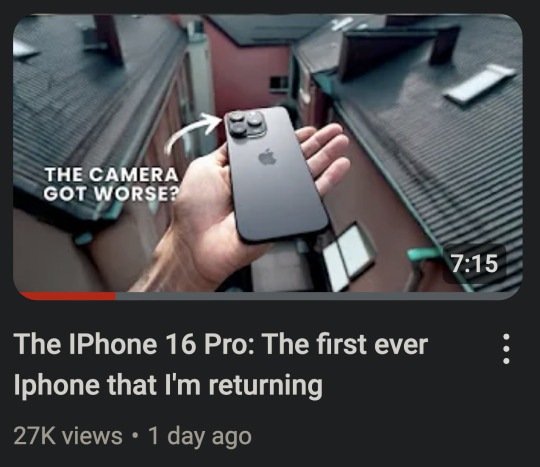

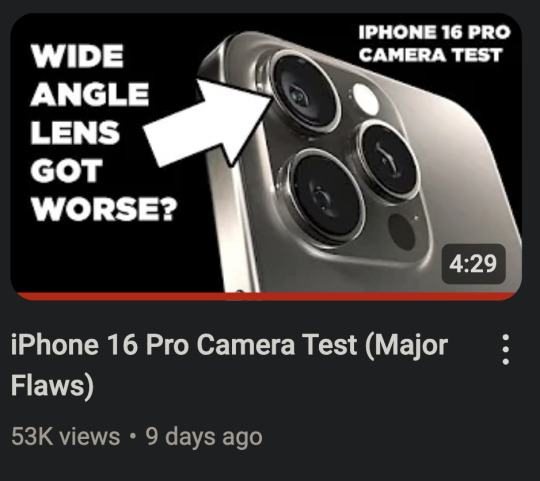
And I suppose this is partly Apple's fault. Their marketing and hype machine always goes overboard. But also, that's just how marketing works. Samsung has a "200 megapixel" sensor and Sony has a "Zeiss" lens. And I think it is unrealistic to expect smartphone companies to say "This product has entered the iterative phase and each new model will only be marginally improved over the last one."
Smartphones (from any brand) have become an appliance. You don't buy a new model of microwave every year. And you don't expect every new model of microwave to have new revolutionary technology. And that is pretty much the expectation you should have with most computer hardware from here on out.
And in some ways, that is a good thing. That means the design of the phone has pretty much been perfected and it will last you a long time if you take care of it. You will not be left behind and your phone will be able to handle any new software for most of its lifespan.
So, is Apple getting lazy or is there a reason their hardware is stagnating?
It seems that neither money nor marketing can change the laws of physics.
They cannot make transistors much smaller. Phones and computers are about as fast as current hardware designs can make them (unless there is a shocking scientific breakthrough). From here on out, heavy compute tasks that are beyond your phone or computer will be done in the cloud on giant computer clusters. Thankfully computers and phones seem to be plenty fast for the majority of tasks we ask of them.
I remember Katrina telling me her new computer didn't seem any faster. And I explained the computing tasks she does regularly were not really affected by the increased power and speed of her new computer. If something took 0.1 seconds before and now it takes 0.05 seconds, that is twice as fast. An increase in speed that looks fantastic in advertisements. But it is hard for our brains to perceive. She just didn't do anything on her computer that took it long enough for her to notice. But having a faster and more powerful computer/phone will increase its lifespan and resale value, so it is still prudent to get the best things you can afford at time of purchase.
And I'm afraid smartphone cameras are hitting their own hardware limitations. They can't make the sensors much larger to get better depth of field and low light performance. And cramming in more megapixels doesn't actually add much more detail, if any.
It's physics.
Again.
You cannot get any more performance out of a small plastic lens. Why do you think pro photographers haul around 10 pound lenses still?
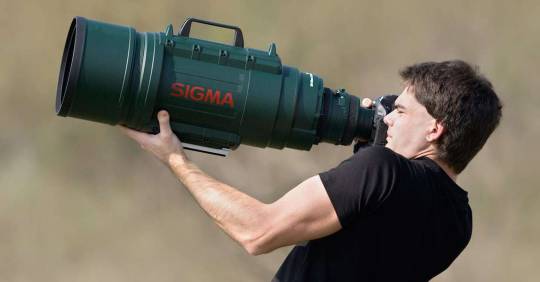
There is a formula for detail that never seems to be explained in any camera marketing.
Here is the simplified version...
Detail = Sensor x Lens
Let's say 1 is perfection. You have a sensor that performs at 0.5 and a lens that performs at 0.2.
The total detail will be 0.1.
But in the new model you increase the performance of the sensor to 0.8. WOW! That's so close to 1!
The total detail will be... 0.16.
Now let's imagine we've discovered a magic, physics-defying tiny plastic lens that performs at 0.8 as well.
The total detail jumps to 0.64!
But we all get sucked into a wormhole because we violated the laws of the universe.
Even if you were to design a near perfect (perfect is impossible) sensor that scores 0.99.
Without that magic plastic lens... 0.198
This is why I put Samsung's "200 megapixel" sensors in quotes. Because when paired with the same tiny plastic lens, there isn't much improvement. And that's why a 12 megapixel DSLR from 10 years ago with a giant honking lens can still capture more detail.
Most of the quality from smartphone cameras comes from the computational software processing. Phones actually take many photos at once and combine them to get you a decent image.

While that is still improving a little bit each generation, those improvements are stagnating as well. Until image processing can do a better job of inventing more detail realistically, smartphones are going to have to obey the laws of physics.
So... why are photographers saying the iPhone cameras are worse?
First, the ultra wide angle lens looks softer in low light.
And if you zoom between 1x and 5x, the images look less detailed.
But neither of those things make the cameras *worse*. In fact, the cameras are better for the most part. It's just that Apple decided to compromise on one aspect to improve another. Probably due to market research telling them most people prioritize certain things over others when taking photos.
They increased the resolution of the ultra wide angle sensor to match the detail of the main sensor, but that seems to have lowered the low light performance of the ultra wide. So in good light, you will see an improvement in sharpness. But they could not increase the sensor size to compensate and smaller pixels can have trouble with dim conditions. They probably discovered that people mostly use that lens in good light and they would appreciate the bump in detail more.
But pro photographers often photograph in more challenging lighting conditions because you can capture a more artistic shot. I don't think I could have gotten this shot on a smartphone.
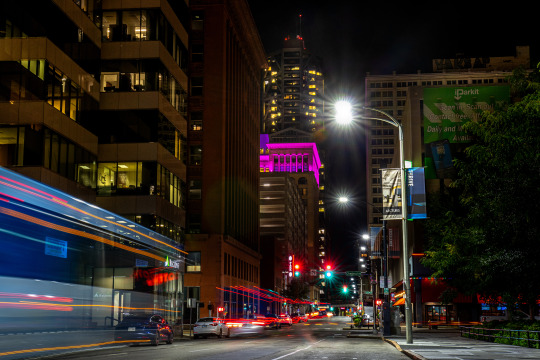
But photo normies are just taking pics of their kids doing weird kid shit.
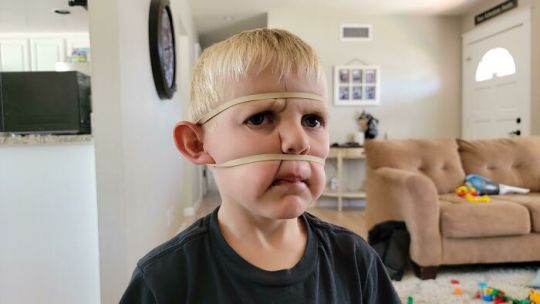
They aren't really trying to push the limits of their ultra wide angle lenses.
And they increased the zoom of the telephoto lens to 5x from 3x because most people never used the 3x. So images at 5x look great now, but unfortunately if you use anything between 1x and 5x, your image will be *digitally* zoomed. Which is never as good as optical zoom. They basically crop the photo, zoom in, and add sharpening.
So they prioritized people having longer reach and more zoom at the expense of that middle zoom range. Every camera system makes tradeoffs and compromises.
And I hate that I always feel like I am defending Apple, because they do have misleading and dishonest marketing regarding a lot of aspects of their tech. But hating on Apple gets more clicks so content creators also make misleading and dishonest claims.
And so we are just surrounded in a circle of hyperbole from all sides.
Now, if you know these limitations, you can change your approach to photographing stuff to keep them from being an issue. You can reap the benefits without dealing with the new compromises.
Here are some tips to help owners of the new iPhone, but also everyone else too.
Smartphone Photography Tips
Whenever possible, try to use the main 1x camera at only 1x zoom. This has the largest sensor with the most detail and works best in the lowest light. Only use the ultra wide or telephoto if you cannot get the photo otherwise. If you aren't sure you have enough light for ultra wide, take the photo, and then as a safety, take two photos with the main camera side by side and stitch them later with a pano app.
"Zoom with your feet" and don't use "in-between" zooms. Let's say your lenses do 0.5x, 1x, and 5x zoom. Even though you have the option to use other zooms, like 2x or 3x, that is going to compromise your picture quality. It is essentially going to crop your photo and enlarge it, which causes a loss of detail. If fact, if you use 4.5x instead of 5x, your picture will probably look like trash. You are always going to get better results if you can move closer or step back so that you are using the native focal length of your chosen lens. For example, let's say you are taking a photo and you judge the best framing to be at 4x. But you still have 10 feet of space behind you. If you back up and then zoom in to 5x, the phone will switch to that lens and you will get a much clearer picture.
Rule of thumb...
1 to 3x... try to move closer.
4 to 5x... try to move back.
If you hit a wall and end up at 4.5x, you might see if you have a panorama mode and try that instead. Switch to your 5x and do the pano. Or you can take two photos and then stitch them together with software later on. (Stitching panos with an app later will give better quality than pano mode, especially in low light.)
Low light needs stability. Get some sort of stabilizing device for low light photos. Either a phone case that lets you stand up the phone on its own or a mini tripod.
This thing folds to the size of a credit card.
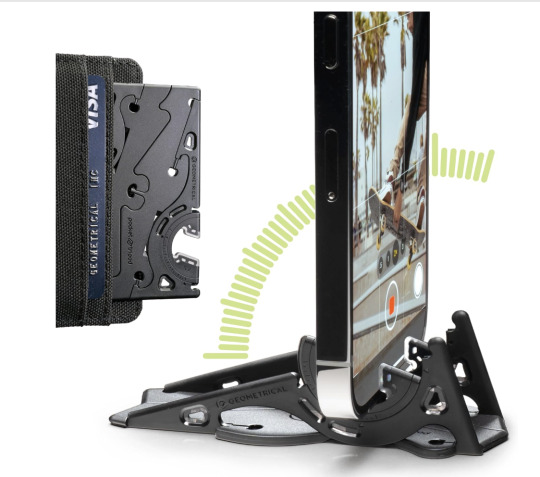
Your phone will detect when it is stable and not being handheld. It will then automatically extend its shutter speed allowing it to drink in more light and give you a better picture.
Tripods are photography magic and will improve your low light photos quite a bit. Motion blur of moving subjects can still be an issue, but photos of a cityscape or landscape will look great.
For selfies, shoot a little bit wide and then crop in. This goes a little contrary to my earlier advice saying cropping lowers detail, but this is specifically for shooting a face. The 0.5x and 1x lenses on smartphone cameras are fairly wide angle. This can cause unflattering proportions with human faces. Wide angle lenses exaggerate distance. Near things look very near and far things look very far. To a wide angle lens, the tip of your nose looks like it is super close but your ears seem like they are a mile away. And that's why you may look a bit "alien" in your selfies.
People's natural instinct is to "fill the frame" with a face. The outer edges of a wide angle lens are more distorted than the very center. So try to keep faces away from the edges of the frame.
And one other trick you can do for selfies and pictures of faces is step back a few feet. Sometimes this is hard, especially with selfies, as your arm is only so long... but if you can take your face photos from just a little bit farther back, you will almost entirely eliminate unflattering distortion. In some cases, just stretching out your arm as far as it will go is enough.
Then you just crop the image with the framing you originally wanted, and your facial proportions will look great.
An example...
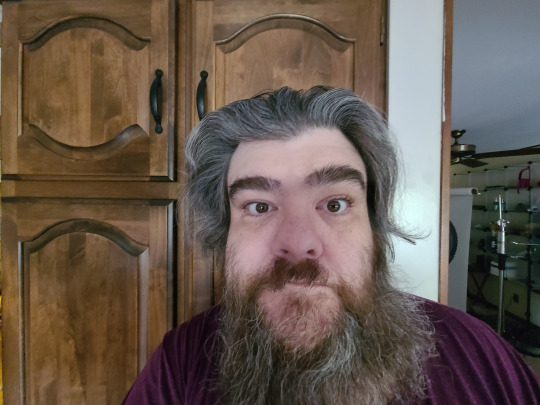
Here the distortion is bad because I am not in the center and the lens is too close to my face. The lens thinks my nose is really close and my ears are in Canada.
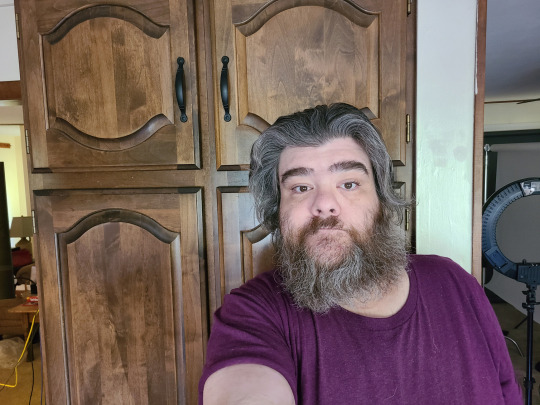
But when the lens is farther back the edge distortion is less prevalent and my nose and ears (relative to the lens) seem roughly the same distance away. So my proportions look great, but I don't quite have the framing I want.
But with a little cropping...
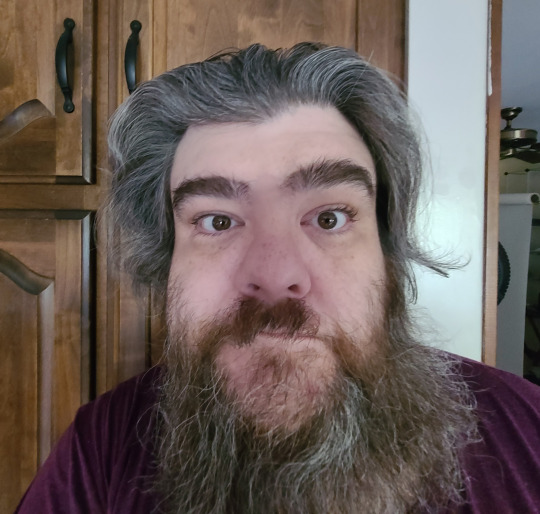
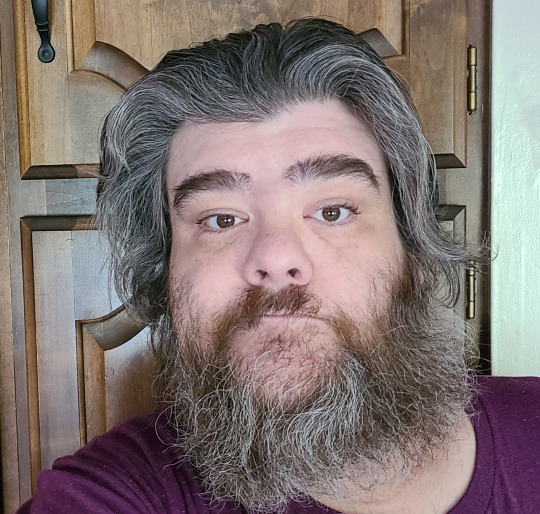
For social media there is still plenty of resolution to crop in. Cropping isn't bad, it's just always better to use it as a last resort or in a special circumstance like this. I get roughly the same framing as in my wide angle shot, but I don't look like I'm behind a door's peephole trying to sell you the Good News.
I wish they made a "mini" selfie stick that only extended a foot or so. With the main camera that is usually all people need to undo any wide angle issues. I have one of those mini tripods and that works well, but there is no activation button so I have to do a timer. Mirrors work great to help you get some selfie distance.
In any case, all cameras have limitations and compromises. Clickbait titles saying something is WORSE THAN THE OLD ONE are frustrating and wrong.
And people upgrading phones every year are silly. All current name brand smartphones have promised at least 5 years of software updates. I think Google and Samsung are offering 7 years on some models. And Apple has always just let you use your phone until it literally will not work with new software. Which has worked out to 8 years in some cases (with a battery swap).
Phones are now appliances. For now, hardware will improve 10 to 15% from generation to generation until physics breaks. So if you want a 50% improvement, wait 5 years and you'll think your new phone is awesome. If you upgrade every year, it is going to be difficult to see the change.
I hope to be starting a little course on smartphone photography in the near future. All modern phones are capable of taking amazing pictures. And as long as you understand their limitations you can mitigate or avoid them. And that is what I plan to teach.
#photography#bound by physics is right#lens size and sensor size are inherently tied to real life physics and there is a hard limit on how small you can make them#even if you continued to miniaturize everything else#your sensors and lenses are capped and cannot physically get smaller without sacrificing image quality#anyway part of the art is to pull things off even with substandard (phone) cameras#commentary#i wouldn't do an iphone tho lol. joke phone. 😂#more people need to understand zoom on phone cameras. if you're pinching in to 'zoom' you're probably failing#most of those are digital zooms which are the equivalent of cropping and enlarging the original image#it's a fake zoom and frankly they shouldn't exist#the only zoom you want is an optical zoom. it's not a zoom if it's not optical
700 notes
·
View notes
Text
☆ cw. fem! reader, husband nanami, cunnīlingus, praise, dirty talk, fįngering, secret freak nanami, hair pulling, mdni.

nanami’s always a gentleman - especially whenever he’s between your legs.
he’s the kind of guy who never forgets his manners. at least, he tries not to. as he’s sprawling both of your plushy thighs apart with a single hand, he’s bringing tender kiss after kiss toward your skin. “may i?” he’d breathlessly murmur as the tip of his nose merely brushes itself down your sopping core. browned, droopy eyes with enlarged pupils that were practically heart-shaped openly leered between the arc of your legs. he’s watching - studying you, silently admiring how your chest heaves up and down after each gasping breath. you’re impatient, so impatient, and a smile creases against his lips once you give a wordless yet needy response of ‘mhm.’
“ah, ah. words, sweetheart. kindly use ‘em for me,” he clicks his tongue, and you let off a sweet, shrilling whimper at the immediate feeling of nanami delicately blowing against your cunt. the cool air that set between your legs from his lips had you arching upward with your toes shamelessly already curling.
fuck.
nanami brought the pad of his thumb near your throbbing opening that was practically drooling before he gave it a teasing kiss. a tiny, popping squelch sobs straight from your sopping pussy and you whined, pouting once nanami licked near your nub before abruptly departing. as his lips hungrily pursed—he glanced back up at you before tilting his head. “oh, i know she’s wet,” he hums, averting his eyes toward your soddened folds before peeking back up at you. “but don’t just let her speak for you. i wanna hear my pretty wet wife too.”
besides his manners, nanami also loved another thing while being between your legs - wearing his reading glasses.
and oh, he just loved the pretty ‘lil whimpers that would slide past your quivering lips as the cold, squared lens would press against your pussy. every time - you’d fog up his glasses while you were uncontrollably rutting your hips against his face.
once he hears that cute, defeated, “p- pleaseee,” leave from your pouty, glittery lips, that’s all it took for nanami to finally dig in.
again, nanami kento’s always a gentleman.
on the other hand, his mouth.. his tongue though? a little more on the dirty side.
constantly - he’s just so hungry.
his lips were so quick at how they just cupped ‘round your nub, and you hear the beginning, loud sucks that echoed through each wall. the first sucks were always the loudest, and you’re gnawing on words that desperately - direly tried to leave your raw throat. instead, though, they just sound inaudible and you’re just whimpering the same repeated cacophonies of ‘kentoooo’ — ‘hngh-’ — or ‘fuck’ ‘s.
as your legs tremor within his firm hold, nanami starts to lave his sticky, pink tongue back ‘n forth until he eventually pried out those adorable squeals from you. he presses his face into your cunt, groaning once your legs mindlessly lock around his neck. “f- fuuuck, ‘ken, keep licking there- oh, my go- hngh-” and with teary, half-open eyes you stared as he’s jerking his head from side to side.
he’s like an animal - feasting between your thighs so viciously to the point where he sometimes forgets to even breathe.
“pretty please kento,” he adds for you, delving his tongue further inside your puffed slit before it swirls in a hypnotic direction. it goes ‘round ‘n round before stretching its way near your g-spot. that earns a small ‘ooh!’ from you as you squeeze your eyes shut. nanami’s tastebuds forevermore salivated for you, and he looked right up at you - pulling his syrupy lips away before swiping his thumb across the crack of his blushed lips. “talk to me, sweetheart.”
“hah- pretty, pretty … pleaseee kento,” you drag your words, letting off a sweet content ‘ah’ once you feel the tangled knot in your stomach unravel. his tongue was so sloppy, curling every which way between your folds before popping right back out. nanami grumbles against your pussy with his blond brows furrowed. the glimmering sleek that strings down his chin sticks against your thighs like constant dripping honey.
you tasted far sweeter than honey though - at least, in nanami’s opinion.
nanami relaxes his jaw — hearing your impatient, wanton cries for more before he gives the center of your cunt its nth kiss. “thaaat’s right- pretty please,” his voice lowers as he praises you, pitching deeper and deeper until he feels your cute ‘lil pulse in his mouth. nanami continued to lie on his chest, pushing the beige bridge of his reading glasses back with the tip of his middle finger. “mhm, such a perfect view,” he purred hoarsely, bringing two thick fingers to slide their way inside of you. he’s staring at your pussy closely, his vision seemingly even more clear after each blink.
within seconds, both digits end up disappearing, and internally, your tummy dips oh-so cutely. his fingers were stubby ‘n thick, making your toes curl even more as every minuscule inch prods into your wet core. as nanami’s tongue kept flicking against your sobbing slit, you’re letting off whine after whine. “heh.. this is probably my favorite chapter,” and as he speaks, your slick continued to fog up both lens of his glasses. “but ah- every great story comes to an end and you’re just about at your climax, right honey?”
“ ‘ken, kentooo-” you’d squeal, each babble of his name turning more breathless. your mind felt like it was just turning into mush. his tongue swirled its way around the spongy textures of your cunt as you felt both of his lengthy fingers pummel their way inside of you. by this point, it felt like you were just about to sink into the mattress.
you felt like you were being pulled in �� he’s still maintaining a grip on one of your thighs, but fuck.
“ ‘m gonna … cum,” and as you spoke those long, awaited words, nanami meets your gaze. even a few glimpses of him between your thighs were enough to make you pulse at a rapid speed. his slick hair - it’s usually so well kept and neat or handsomely parted. now, it’s ruffled with blond strands sticking against his forehead with the help of his sweat. a hand of yours finds its way through his hair, roughly yanking near his soft roots. your eager tug at his hair was so hard that his nose is just tickling against your clit.
you felt a smile stretch across his lips as he’s still relishing in your fervor. you were right there … right fuckin’ there and at the brink of your very edge. from head to toe, your body felt like it was on fire - just sizzling with anticipation at a scorching temperature of a hundred degrees.
“c’mon then, sweetheart,” he throatily rasps, wetly pulling his twinned digits from your pussy. from top to bottom, you coated his fingers with your slick that had such a carnal-like shine to it. as his ruby, swollen lips kept latching against your folds, he grumbled at the arising friction in his slacks. “make a mess in my mouth, go on, pretty- give it t’ me please.”
“cum- ‘m cumming!” you’d shriek, chewing each high-pitched vowel and syllable that mewled from your lips. the pool that stirred into the inner depths of your stomach was finally at its peak. you slouch back in jubilant pleasure, loosening your grip on his fleecy strands as his tongue nibbles against your convulsing bud. your body’s just one single word - hot, and you felt like you’d just exploded right then and there. all nerves in your body violently erupt as you’re riding out your orgasm on his tongue with wobbly, numb legs.
the patterns of your breathing slowed significantly, and nanami whispered out husky, ‘thank you’ ‘s as his lips were trying to shower your dripping cunt with appreciation kisses. it’s almost sweet, in a racy way. the once steady beat of your heart felt like it was preparing to pound straight out of your chest, and you flopped your head back against the fluffed pillow that lay underneath you. nanami brings a hand toward your pussy, giving it a soft, praising pat.
your essence sloppily paints all against his palm and he flashes you a sheepish, pussy-drunk grin. “mhm, thank you, sweet girl,” and you honestly didn’t even know what he was thanking you for. ‘till the very end, nanami never forgot his manners, including at the moments where you’ve just drenched his entire face from nose to chin with your treacly slick. “and, hah- thank you,” his bleary, downcast eyes dart towards your slobbering pussy. from the hood of your clit to the very opening near the bottom, you’re soaked - cascading a pretty, wet stream of your shimmery wetness.
with a sticky ‘mwah,’ — nanami gives the center of your pussy its final concluding kiss, still hearing your shallow breaths from above as you’re trying to get over your overwhelming high. everything felt like it was spinning in circles, and the cold, glassy lens of nanami’s glasses pressing against your folds snapped you straight back into lewd reality. “think i’ll rate this book, five stars.”
and as you let off a surprised moan once he’s suddenly turning you over to lie on your back, you heard the familiar ‘zip’ of nanami’s slacks. breathily, he pants as he grinds his angry bulge against your bare cunt, sucking his teeth as you instinctively arched for him.
“fuck… sweetheart. think it’s time for the epilogue. now bend just a liiiittle more for kento, atta girl.”

#★vegasbaby.#im ovulating look away idk 🧌#nanami smut#nanami x reader#nanami kento smut#nanami x you#nanami kento#jujutsu kaisen smut#jjk x reader#jujutsu kaisen x reader#jujutsu kaisen x you#jjk smut#jjk x you#aggnm
5K notes
·
View notes
Text
Solar Eclipse in Totality
These photos were both enlarged digitally with Lightroom, to compensate for the short reach of my 200mm telephoto lens! 🙂
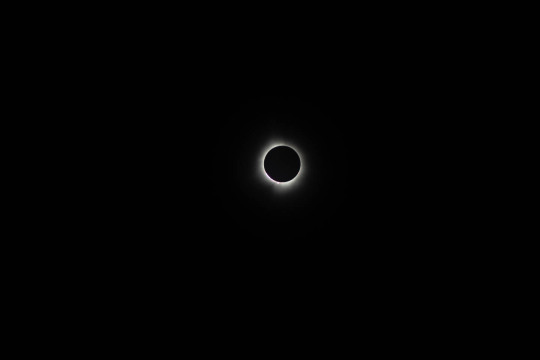
View On WordPress
0 notes
Text
Multitasking
[Ao3 Mirror] Pairing: Megatron/Reader/Soundwave Rating: E WC: 600 Contents: Gender/Sex neutral Reader. kinda dubcon voyeurism, but it's Soundwave so like, what do you expect? === Written for Day 1 of @tf-kinktober2024 but I'm bad at posting things on time lol ===
There were few luxuries Soundwave afforded himself, few that would interfere with his near single minded focus. It was fortuitous, then, that his aptitude for surveillance dovetailed so neatly with his desire for you.
The other members of High Command were perfectly pleased to turn their attention away from their actual duties and to instead busy themselves with their little organic distraction. Not that this was your fault, you are simply so small and delicate and soft in their collective servos. For the record, Soundwave did enjoy when his workload lightened enough for him to be able to be the one cradling you in his spindly digits, even if it was not fundamental to his own satisfaction. Still, Soundwave does resent his fellow officers' inefficiencies, because unlike them, Soundwave can multitask.
With just over half his processor focused on the sifting of actual surveillance data from his Earth-based network, the other almost-half sorts through cameras aboard the Nemesis itself. He calculates the likelihoods on where he'll find you- his schedule dictates you should be awake with your diurnal sleep cycle and when he cross references that with which officers are off duty... It doesn’t take him long. Well below his estimated time in fact to find what he’s looking for. The habsuite is familiar- even from the elevated, unnatural angle of the camera’s lens- and it is occupied.
Soundwave is almost surprised; Megatron is well known among the crew to have no compunction on enjoying his pets anywhere he likes. In his own berth is practically mundane in comparison. But there he is, lounged back against one wall, half-turned with his legs spread. One servo lazily strokes his own spike, his warframe claws drawing thin lines up and down the underside, while his other holds... you.
Soundwave’s fans click on.
So tiny in his liege's palm, Soundwave has to zoom in on the feed, enlarging the image until it’s nearly entirely Megatron’s unpainted plating and the shining sweat on your skin. Soundwave watches you, focuses on how your limbs twitch and twist as Megatron’s glossa glides against your body. You're close, Soundwave can tell from the tremors in your legs, the rise and fall of your torso, how your mouth opens in silent cries. Megatron slows, changes his angle before you can overload. And in the tight frame of the camera, the corner of Megatron’s intake quirks upwards, revealing a few more of his sharpened dentae.
Was he so pleased with your vocalizations, with having denied you? Soundwave zooms out a touch, to capture all of his lord’s faceplate and-
Red optics meet his through the screen, white arpetures burning directly into the camera. His dermals still curled into as much of a smug grin as they can while also licking incessantly between your legs. If you even notice his distraction, you don’t seem to show it, tiny servos clutching at Megatron’s plates in fervid desperation.
::How is the angle, Soundwave?:: To the untrained optic, Soundwave knows his reaction to Megatron's com is nearly imperceptible. Still, Soundwave adjusts his posture, self-aware in the way only Megatron can make him feel.
Now, Soundwave understands that Megatron's unusual position- half turned, legs spread to frame his spike- was intentional. By way of response, Soundwave sends him the feed.
He watches as steam rises from Megatron’s vents, the servo on his spike squeezing at the base, his optics darkening as he watches himself. You, in his palm, have latched your tiny hands onto his digits, body rolling into each teasing lick.
::Join us.:: He orders after a moment. ::And send me the full file after.::
#megatron x reader#soundwave x reader#transformers#tf x reader#transformers x reader#kinktober 2024#kinktober#<- lets see if thats blacklisted#valveplug
250 notes
·
View notes
Text
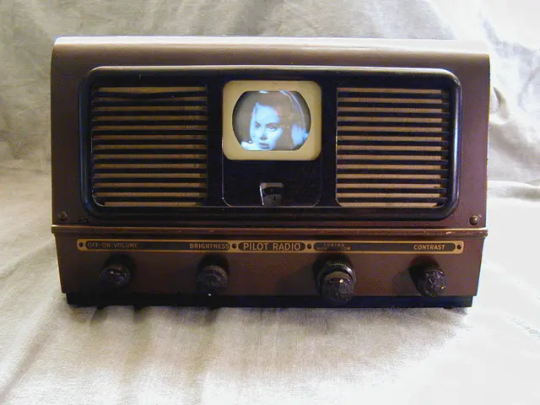
The Pilot TV-37 “Candid” was introduced in 1948 at the then-amazingly low price of $99. Most 1940s TVs sold for hundreds of dollars, the cost of a decent automobile. Pilot made this set for only a few years but sold a lot of them during that time. You could get a magnifying lens to place in front of the picture tube for an additional fee. (Click to enlarge the picture.)
Originally posted January 9, 2014. | Tumblr Archive
574 notes
·
View notes
Text
girls on film - jonathan byers

Jonathan Byers x shy! female! reader
Main Masterlist
ST Characters Masterlist
Summary:
When you get assigned a photography project with Jonathan, you end up trying something…experimental.
Warnings:
Smut (18+), unprotected p in v, oral (m receiving)
Word Count: 5.1k
A/N:
So excited for my first Jonathan fic! I’ve been working on this for weeks so I’m so happy it’s finally done 😅

You adjusted the settings on your Nikon F3. Attaching the 55mm lens, you held the camera up to your eye, focusing on your subject - your dog. You were grateful for the fast shutter speed on your new camera, because the Border Collie did not sit still.
“Lucy, stay!” You commanded, hoping you could just get this shot for your photography class. The long haired black and white dog looked at you with her tongue hanging out of her mouth. She listened, but you knew you had only moments before she took off, ready to run the 5 acres of land your family lived on, chasing after the livestock.
You snapped the photo just in time before she stood and ran. You hoped you got a good one, but there was no way to tell until you developed the film. You did not want to get an F on this project just because your dog wouldn’t cooperate.
You sighed as you removed the lens from the camera body, storing both back in their bag. You loved photography - it had become a passion of yours your freshman year of high school. It was your favorite form of art. And you could do it completely solo - you honestly hated interacting with your classmates. Not that there was anything wrong with them (well, not most of them, at least), you just preferred your own company.
You slung the camera bag over your shoulder and walked through the yard and back to your house. The smell of dinner wafted from the kitchen, but you headed up to your room instead. You carefully sat your camera bag on your desk and fell back onto your full size bed.
Your room felt childish. Nothing had changed since middle school. There weren’t photos with friends decorating your mirror, no gifts from your nonexistent relationships. Your bed was still covered with stuffed animals (though you’d never admit you still liked sleeping with them). The walls were painted a pale pink. The only recent decorations were the prints you made of your photography.
Lucy, the farm animals, your family, school events you were asked to photograph for the yearbook. Flowers, photos from finally trips, anything interesting you’d found with your camera on you - which it usually was.
You hoped these photos of Lucy turned out so you could add them to the collection. The left side of your room needed something new. Hell, your life needed something new. Something fresh. Something exciting.

The next day at school, you snuck into the dark room during lunch. You had the space to yourself, which you were grateful for.
Firstly, you mixed together your chemicals so they would be ready, pouring them into their respective trays. You then unloaded the roll of film from your camera. You looked over the negatives, finding some photos of Lucy that turned out great - thank god. You turned the negative around, placing it in the carrier before carefully removing any dust. You placed the carrier in the enlarger. You adjusted the size, using the focusing wheel to make sure it was completely in focus. You adjusted the lens aperture to F8, sliding a filter into the enlarger.
Next, you took a sheet of the photo paper and placed it into the easel. You exposed the photo onto the sheet of paper for about 5 seconds. You moved the sheet to your tray of developer, sliding it in quickly and carefully, then moved the tray gently, watching as the chemicals moved and your photo of Lucy developed in front of your eyes. After 60 seconds, you used the tongs to remove the photo and place it in the stop bath. You slid this tray around, too, using a separate pair of tongs to remove the print and place it into the fixer. After 30 seconds, you checked the thermometer in your tray of water, finding it perfectly at 68 degrees Fahrenheit. You removed the photo and placed it in the tray of water for 2 minutes, emptying and refilling the water a few times to make sure to wash away all the chemicals. When you were done, you hung the black and white photo to dry and continued with the others you wanted to print.
When you were done, you flipped the lights back on, gathering your prints. You checked the clock on the wall and were relieved to see there was still a decent chunk of lunch left - hopefully there would be some pizza left to grab. You pulled the door open and immediately smashed into something - or someone. You stumbled back, your photos falling from your hands.
“I’m so sorry! Here, let me help,” the guy said, crouching down to gather your stuff for you before you had the chance to. He stood, handing your stuff back, and you found yourself looking into the brown eyes of Jonathan Byers. He looked down at your photos as he handed them over. “Sorry, I didn’t know anyone was in here.”
“It’s okay,” you assured him, a blush creeping onto your cheeks. “I just finished up in here.” You brushed your hair behind your ear, feeling shy now that you were no longer in the safety of the darkroom alone.
Jonathan gave you a small kind smile, one that had your heart beating a little harder in your chest. “Your photos look great, by the way,” he added, gesturing to the prints clutched safely in your grasp.
“Oh, thanks,” you said, avoiding his gaze. You cursed yourself for the way you always got shy around other people. It was Jonathan, he was probably the nicest guy in your senior class.
Maybe it was the fact that you’d had a crush on him for forever, watching him in photography class, noticing the beautiful photographs he produced every single time. He was quiet, kind, kept to himself just like you. You had to admit you wanted to get to know him better, but you were scared.
“I’ll, uh, see you in class,” Jonathan said, that same friendly smile on his face. You nodded and slipped by him out of the door. You heard it close behind you as you quickly walked to the cafeteria, hoping there would be something left for you to eat.

You walked into 7th period Photography, taking your seat at your usual desk in the back. Mr. Howard was at the front of the room, talking with another student from last period as the rest of the class filed in. Jonathan gave you a small nod when he walked in, and you returned it before turning your head to hide the blush on your cheeks, again.
You turned in your work as class began, pleased with how the photographs of Lucy had turned out. About halfway through class, Mr. Howard clapped his hands together, commanding the attention of every student.
“Alright, class.” He drummed his hands on the desk like a drumroll, a mischievous smile on his face. “It’s time for your portrait partner project assignments!”
The whole class let out a chorus of groans. Mr. Howard only laughed. “Your partner assignments are posted on the bulletin board. Please check after class.”
Class went on as usual, but you couldn’t focus, too worried about who you would be paired with. You hated working with others, honestly. You preferred being alone whenever possible.
When class was over and most of your classmates had already left, you tentatively made your way over to the board. You scanned the list with your finger tracing down the list of names until you found your own, and the name beside it - Jonathan Byers.
It could definitely have been worse. Jonathan was nice, and he was talented. But he was also…really cute.
“Looks like we’re working together,” a voice came from behind you, and you turned to see Jonathan smiling politely with his bag over his shoulder.
“Looks like it,” you agreed, unable to make eye contact with him. “Do you…want to work at my place or yours?”
“Uh…” He thought for a moment. “My mom has work until late and my brother has his D&D campaign, if you want to come over?”
“Sounds good,” you said. You hadn’t exactly been thrilled at the idea of Jonathan in your middle school style bedroom.
“I can give you a ride, if you want?”
The thought of riding in Jonathan Byers’ car alone with him terrified and excited you. You’d never been alone with a boy before.
“Okay,” you agreed, looking down to hide the blush on your face. You were pretty sure he saw right through you, though - you weren’t exactly being subtle.
He nodded towards the hallway, indicating for you to follow him out of the classroom. You did, and the two of you walked out to the school parking lot together. No one paid you any mind.
He led the way to his rusted Ford LTD. After unlocking the doors for you both, you slid into your respective seats. It took him a few times to get the car started, but eventually it did.
The Byers lived a bit out of the way, a good distance from the main part of Hawkins. So did you, but you had never been out this way. He drove up the dirt driveway of the small house, parking off to the side to leave room for his mother’s car.
You had never been to any of your classmate’s houses before - not since middle school when you were best friends with Chrissy Cunningham, before you drifted apart. It was strange being here alone with him, and the fact that you liked it was even stranger.
Jonathan unlocked the front door and led you inside, walking down the hall towards what you assumed was his bedroom. His room was tidy, his bed made and no clothes strewn across the floor. He had a turntable with stereo on his dresser with a large collection of records and an Evil Dead poster on the wall, which you noticed immediately.
“That’s my favorite movie!” You said, suddenly excited. “I love Ash.”
Jonathan smiled, gently setting his bags on the bed. “It’s a great movie. One of my favorites, too. You like horror?”
“Yeah, of course,” you said. “My favorite genre.”
You started browsing through his records. He had a lot of great music. You picked out The Smiths’ debut album. “Can I?”
“Yeah, of course,” he said. He began pulling his camera out of its bag and getting it set up while you lifted the cover of the turntable and placed the record down gently. You turned it on and lowered the arm to the record, the music beginning to fill the room, quiet enough to just fill the background while you talked.
Jonathan turned to you with his camera in hand - a Pentax MX, you recognized. He fiddled with his settings a little, then smiled at you. “Ready to get started?”
“Yeah,” you said, suddenly shy again. “Where do you want me?”
“Um…” He thought for a second, looking around the space. “How about just against the wall here? Just a plain background. I’ll open the curtain.”
You moved to the wall, adjusting your hair as you walked. Jonathan held his camera up to his eye, making sure he was ready to shoot.
He directed you in a series of poses as he took photo after photo. It was extremely awkward - you were always the one behind the camera. You didn’t like being in front of it. But Jonathan was a complete professional, making you feel as comfortable as possible. You started having fun about the time the song switched to Pretty Girls Make Graves.
“Let’s take a little break, then we can switch,” he said after a good 30 minute session, lowering his camera. “You did great.”
As Jonathan put his equipment away, you wandered around his room. You spotted several books on photography on a shelf, and you reached for one, opening it up and flipping through it.
It was filled with black and white photographs, all of them beautiful portraits. You slowly looked through the book, admiring the stunning work, until you reached a section that made you stop, a blush creeping onto your cheeks.
“I don’t know how people have the confidence to do this,” you said, looking down at the tasteful nude photos. Women posing with their breasts fully exposed to the camera, each looking absolutely beautiful.
Jonathan looked over your shoulder. “It’s just art,” he said, a small smile on his face. “If you’re working with a photographer you’re comfortable with…I imagine it’s easy.”
You shook your head. “I can’t imagine.”
It was silent for a moment as you both gazed down at the photos. “Would you…ever want to try?”
Your head snapped around in his direction, your eyes wide. “What?”
“You- you could try it,” he said, suddenly very nervous. “We could try it. If you want to.”
You felt yourself blushing all over your entire body. You slowly closed the book, turning around to look at Jonathan. “You…want to take these kinds of photos…of me?”
“Yeah, why not?” Jonathan said with a shrug and that shy smile. “I’m a photographer. You’re modeling. And…you’re beautiful. You’d do amazing.”
You couldn’t believe what he was suggesting. Jonathan wanted to take nude photos, of you?? But you had to admit to yourself…you were intrigued. You hadn’t had any exciting experiences in your life. It was about time for something to happen.
And did he just call you beautiful?
“O…okay,” you said, trying to find your confidence. “How…do we do this?”
“Well,” Jonathan started. “You can, uh…undress, and I’ll get my camera ready?”
Your hands were shaking as you nodded slowly. “Okay,” you said. “Let’s do this.”
Jonathan turned around, giving you privacy as he fiddled with his camera. You lifted your shirt over your head and dropped it to the ground. Next you undid your jeans, pushing them down your legs and dropping them into a pile with your shirt. You took a deep breath before you reached behind your back and unhooked your bra, dropping it and then sliding your panties down your legs.
Completely naked, you finally fully realized what you had gotten yourself into. You were currently standing naked in Jonathan Byers’ bedroom. You felt your nipples hardening as they were exposed to the cold air. You held a hand across your breasts, as if you weren’t completely naked from the waist down too and about to have nude photos taken. “Okay…I’m ready.”
Jonathan turned around, his eyes going wide when he saw you. His gaze raked over your body before meeting your eyes again. “You- uh- you look- you look great,” he said, pink blush rising on his cheeks.
You couldn’t help but smile. It made you feel better that he was nervous, too. “Thanks,” you said shyly. “Um…I guess we should get started?”
“Oh yeah, yeah,” Jonathan said quickly, snapping out of whatever trance he was in. “Um, you can stand over there?” He pointed to the blank space on his wall.
You moved over there, dropping your hands from your breasts. Jonathan locked eyes with them for just a moment before he was looking at your face again. “Want me to put on some music?”
“Please,” you said, feeling like it would help you get in the zone and be more comfortable.
Jonathan walked to the record player, flipping through his records before pulling one out and placing it on the turntable. David Bowie’s voice carried through the room, and you smiled. “I love Bowie.”
“Me too,” Jonathan said, returning your smile. He moved back in front of you and lifted the camera to his eye. “Okay, just pose like…this?” He said, miming the placement of your arms.
You held your arms behind your head the way he showed you, kneeling down on the carpet. “Like this?”
“Perfect,” he said, snapping a bunch of photos. “You look beautiful.”
You blushed deeply. Having your naked body on full display was a new, terrifying experience, but it was also…exhilarating. You were kind of loving it.
Jonathan hadn’t felt so inspired in ages. Something about your body was perfect for photography, he thought you looked beautiful and you photographed like a real model. He could tell you were shy, but you were doing an amazing job. These photos were going to be some of the best he’d ever taken.
He instructed you through different poses, encouraging you the entire time. The longer the session lasted, the more comfortable you felt. By the time a few songs had passed, you were honestly having a great time.
“How about you sit on the bed for this one?” Jonathan said, gesturing to his bed. You sat down on the edge of it, looking to Jonathan for more instructions. “Just hold your arms like…this.”
You did your best to copy what Jonathan was trying to show you. “Like this?”
“No, kind of like…” He lowered his camera to hang around his neck and moved over towards you. “This.” He reached for your arms and began to pose you, but his fingers accidentally brushed over your hardened nipple. You gasped, jumping slightly at the sensation, and Jonathan looked up at you with wide eyes.
“I’m so sorry!” He said, dropping his hands. “I didn’t mean to-“
“It’s okay,” you said, giggling lightly. “I…didn’t mind.”
Jonathan looked into your eyes, like he was searching for something. His gaze lowered to your lips, then back to your eyes. The next thing you knew, he was leaning in, and you felt his lips press against yours.
Your heart pounded in your chest, your eyes falling closed as you kissed him back. His hand came up to cup the side of your head, his thumb caressing your cheek. He ran his tongue across your bottom lip and you opened, allowing his tongue to explore your mouth completely, dancing with your own.
You couldn’t believe what was happening. You were finally having your first kiss - at 18, but whatever - and it was with Jonathan Byers. While also naked.
Your hand slid beneath his shirt, feeling the skin of his stomach and chest. He pulled back and pulled it over his head before moving back to your lips, kissing you hungrily as his hands roamed your bare skin.
You pulled away, suddenly nervous. Jonathan looked as if you’d just yelled at him, like he felt bad for overstepping your boundaries, which he hadn’t done at all. “Have you…ever done this before?” You asked.
Jonathan looked back at you, this time a slight blush on his cheeks. “Uh, no. Never.”
“Me either,” you admitted, which made Jonathan smile a bit.
“I thought you’d think less of me,” he said. He reached for your hand and held it in his own. “Like I’m the Freak no one wants to go out with.”
“I don’t think that at all,” you assured him. It was your turn to place your hand on his cheek and turn him to look at you. “I think you’re really handsome. And the girls at school are missing out if they overlook you.”
Jonathan smiled again, his cheeks tinged red. “I think you’re the most beautiful girl in school.”
You blushed as well, your whole body heating. “That’s definitely not true.”
“Well, I think it is.” Jonathan caressed your face with the back of his hand, looking into your eyes. “I wish you could see yourself the way I see you. The way I’ve always seen you.”
“You noticed me?” You were surprised, because no one noticed you. You were grateful you weren’t exactly picked on, but it would be nice for your classmates to know you’re there.
“Of course I did,” Jonathan said, like it was obvious. “You’re the best photographer in school. Your photos are always beautiful. You have so much talent, and you’re so pretty and kind.”
You couldn’t believe what he was saying. He had noticed you? And not only noticed you, but felt those things about you like you had about him?
“I think you’re the best photographer in school,” you said shyly, unable to meet his gaze now. “And you’re always kind, even when people are dicks to you. And you’re so handsome it makes my heart beat faster when I see you.”
Jonathan smiled, looking down at his hands. “I can’t believe you feel the same way about me.”
You thought for a moment. You could keep sitting here being all shy, or you could take what you wanted. You could stop sitting on the sidelines of life and do something you want for once. Something he wants, too.
You turned to him, and he turned to you. You moved in, and he did the same. Your lips pressed together again, and you kissed him eagerly this time, your hand resting on his face as he placed his hand on your hip. You gently pushed him down on the bed, and he obeyed. He watched wide eyed as you climbed onto his lap, grinding down on the growing bulge in his pants. He groaned and tightened his grip on your hips.
“God, you…you look so beautiful,” he said breathless, eyes roaming your body hungrily. You grabbed his hands and slowly trailed them up your body, rubbing over your ass and up your sides until you placed them over your tits. His eyes somehow went even wider, a rush of air leaving his lips. “J-Jesus Christ.”
“You can touch me,” you said, bolder than you felt. “You can touch me wherever you want.”
Jonathan let out a shuddering breath and you removed your hands, leaving him there to do as he pleased. He slowly began massaging your tits, thumbs running over your peaked nipples, making you shiver. You rotate your hips as you grinded against his lap, feeling him growing harder and harder beneath you. His expression looked totally fucked out already and you’d barely even touched him.
Your hands slid under his t-shirt again. “Why don’t you take this off?”
He sat up quickly, pulling his shirt off and over his head. You took in the sight of his bare chest, hands roaming the now exposed skin. Then you surprised him by moving farther down his body. He breathed in a gasp of air as your hands began undoing his jeans.
He watched with rapt attention as you got them undone, lifting his hips to help you pull them and his boxers off his body. His cock sprung free, long and hard and leaking precum already. He was bigger than you expected.
“H-oh shit,” he breathed out as you wrapped your hand around his cock, feeling it twitch in your hand. You moved forward and wrapped your lips around his tip, running your tongue around it experimentally. His hips bucked up- “Sorry! Shit, sorry-“ but you didn’t mind. You liked that he was so weak for you, so desperate for more of your touch.
You began bobbing your head up and down his cock, taking more of him every time you lowered your head. His hands were gripped in tight fists in his bed sheets, like he wasn’t sure what to do with them but needed to hold onto something.
You pulled off of him. “You can touch me,” you reminded him, a little giggle in your voice. “I want you to touch me.”
Jonathan just nodded, but when you went back to sucking his cock, he grabbed the back of your hair with one of his hands. He wasn’t shy about his moans - either that or he couldn’t help it - but you were loving it. You had never done this before, but the noises he was making let you know you were doing a good job. An amazing job, apparently.
“Baby,” he moaned, high and desperate. “Feels so good. Oh my god- it’s so good.”
You almost laughed, he was so cute, but you kept it together as you took him deeper and deeper with every pass, running your tongue around his tip every time you reached it.
“Fuck, fuck,” he moaned, his breaths coming in shorter bursts. “I’m gonna cum if you don’t stop right now. And I really…really wanna do more with you.”
You wouldn’t have minded making him cum with your mouth, but doing more sounded way too enticing. You pulled off of him and he watched as a string of saliva connected your lips to his cock, dropping his head back on the pillows with a groan.
Crawling up his body slowly, you placed kisses as you went, making him shudder. When you reached his lips you kissed him again, his hands sliding up your sides.
“God, you are…so hot,” he groaned, hands squeezing the plush skin of your ass before sliding back up your body, enjoying every inch of you.
“So are you,” you hummed, kissing his neck, biting and sucking when you found the spot that made him moan. Then, to your surprise, he grabbed you and flipped you both so he was on top.
He started kissing your neck, making you moan beneath him as he left purple hickies on your skin. You felt his hard cock pressed up against your core, and he pulled back, looking at you with pleading eyes that contradicted his next words.
“Are you sure you want to do this?” He asked, his voice raspy. It was obvious he very much did. “We don’t have to. If you want to stop now, we can.”
“I don’t want to stop,” you said quickly. “I…want to keep going. Do you have a condom?”
“Shit,” he hissed. “No. This isn’t, uh, something I do often.”
You giggled. “It’s okay. We can still do it. Just, uh…pull out?”
Jonathan nodded vigorously. “I can do that.”
He reached down between your bodies, wrapping his hand around his cock as he dragged the head between your folds, gathering your slick on him. Then he was pressing at your entrance, gaze darting back up to look into your eyes.
“Let me know if you don’t like it, okay?” He said. “I can stop any time. We don’t have to do this.”
“Jonathan,” you said with a small laugh. “It’s okay. Just do it.”
He nodded, then looked back down to where you were connected as he slowly began pushing inside. It stung at first, the intrusion unfamiliar and painful the farther he filled you, but it eased into a kind of pleasure before long. You held onto his shoulders tightly.
Jonathan groaned when he bottomed out inside of you, body shuddering from the sheer pleasure of being buried inside your tight, wet walls. It felt amazing for him, better than his hand, better than what he dreamed sex would be like. You were perfect, like your body was made for him, made to take him.
“Oh my god, Jonathan,” you moaned. “Feels so good. You’re so big. Please move, need you to fuck me.”
He moaned, hand gripping tightly in the bed sheets again. “Fuck, if you say things like that I’m gonna cum faster than I want to.”
He pulled back out slowly before rolling his hips back into you. It felt even better that time, a high whine coming from your lips. Reassured seeing that you were enjoying it, he set a steady pace, thrusting into you quickly. He buried his face in your neck, moaning as he truly began to fuck you.
“God, this is…fuck, feels so good. You feel so fucking good. Shit, I can’t-“ He cut himself off with another moan, high and whiney and so fucking hot.
You tangled your fingers in his hair, pulling lightly at his dark brown locks. You wrapped your legs around his waist, guiding him to fuck you faster, which had him moaning your name over and over again.
“Jonathan,” you moaned, back arching off the bed. “Please, I-“
Jonathan reached between your bodies, fingers beginning to rub at your clit. He had the idea, but didn’t exactly know what he was doing.
“Rub in circles,” you told him, although what he was doing didn’t feel bad. He did as you instructed, rubbing quick tight circles on the sensitive bud. “Fuck, yeah, just like that. Just like that.”
The combined feeling of his cock deep inside you and his fingers working against your clit had a coil tightening in your belly, your peak coming faster and faster. “Jon, I’m-“
Your orgasm crashed into you, having you seeing stars as your back arched off the bed, pussy clenching around him as you called his name again and again. “Jonathan! Oh my god, Jonathan-“
It sent Jon over the edge too, crying out loudly as he quickly pulled out and pumped his cock a couple times as he shot his load all over your chest, stomach and thighs. It was so much, and you had never seen a guy cum before. You watched him with wide eyes, the sight turning you on all over again.
You both caught your breath, trying to calm down after all that. Jonathan reached for a dirty shirt on the floor and cleaned you off, then laid down on his bed next to you.
“That was absolutely incredible,” he breathed, wrapping an arm around you. “You were incredible.”
“That was amazing,” you agreed. He leaned over and pulled you into a passionate kiss.
“Be my girlfriend,” he said, thumb rubbing circles on your hip.
You raised your eyebrows. “Really? You mean it?”
“Of course I do,” he laughed. “Haven’t you realized how into you I am? Especially after all this?”
You blushed, hiding your face in his chest. “Yes. Of course I’ll be your girlfriend.”
The two of you cuddled in bed for a while longer, until you looked over at his alarm clock and saw the time. “Oh god. I’m gonna be late for curfew.”
Jonathan looked over at the time, too. “Oh, wow. I didn’t realize it had gotten so late. Do you want me to give you a ride home?” He asked. “We can, uh, do your part of the project tomorrow,” he added, cheeks tinged red.
“Okay,” you agreed, smiling and giving him a kiss. “Sounds good to me.”
You both got dressed, trying to look as if you hadn’t done what you had just done. You left his room and headed down the hall - seeing Jonathan’s mom, Joyce, sitting in the living room.
She smiled at you awkwardly. “Hi, so nice to meet you.”
You took her hand in yours, blushing furiously as Jonathan avoided eye contact with his mother. “Nice to meet you, too,” you said, giving her your name.
As you and Jonathan walked out hand in hand, he turned to you. “She definitely knew what we did.”
“Oh yeah, definitely.”
tag list
@shes-an-odd-bird @cassandracorvo
#jonathan byers#stranger things#jonathan byers x reader#jonathan byers smut#stranger things smut#jonathan byers imagine#jonathan byers blurb#jonathan byers oneshot#jonathan byers one shot#keeryhours writes#jonathan byers x you#jonathan byers x female reader#jonathan byers x fem!reader#jonathan byers x fem! reader#jonathan stranger things#stranger things x reader#jonathan byers x y/n#stranger things imagine#jonathan byers fluff
119 notes
·
View notes
Text
Round 2 - Mollusca - Polyplacophora
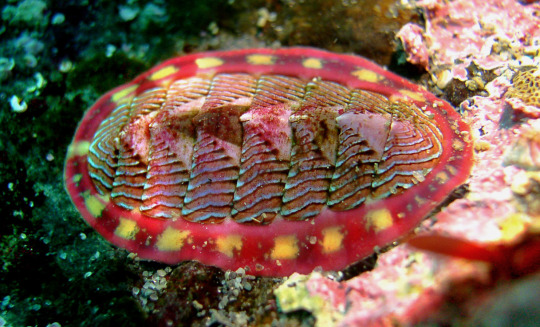
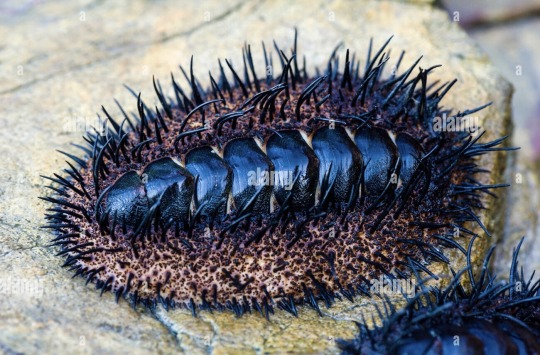
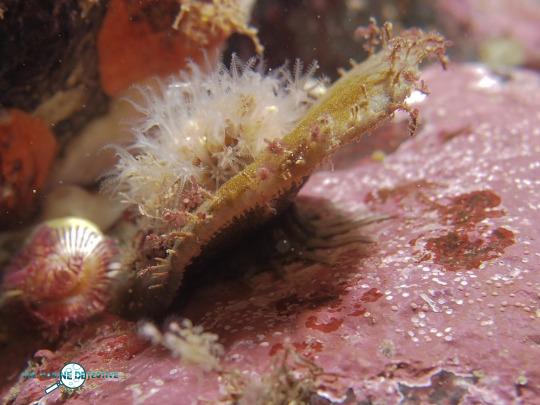
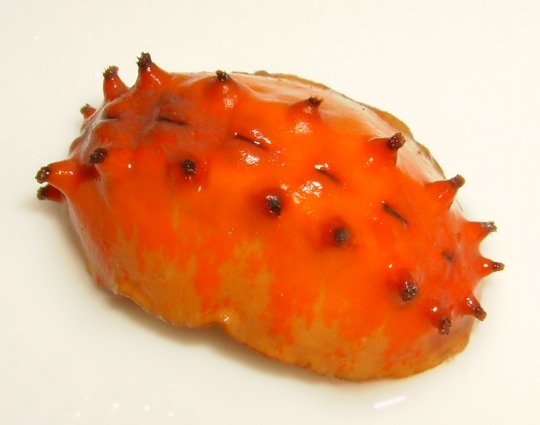
(Sources - 1, 2, 3, 4)
Our first class of molluscs is Polyplacophora, commonly known as “Chitons”, and less commonly known as “Sea Cradles”, “Coat-of-mail Shells”, or “Suck-rocks”.
Chitons have a shell composed of eight separate plates, or valves, which overlap slightly. This allows the chiton to have protection without sacrificing flexibility, as the plates allow for some articulation and even for the animal to curl up into a ball when dislodged from rocks. The plates are circled by a skirt called a girdle, and in some species the tissue of the girdle covers the plates (image 4). Underneath the shell, the majority of the body is a muscular, snail-like foot. Gills hang down into the mantle cavity on either side of the foot. The mouth is also located on the underside of the animal and it contains a mouth with a tongue-like, tooth-covered structure called a radula. The radula is used to scrape food from rocks. Chitons have unique organs called aesthetes, which consist of light-sensitive cells just below the surface of the shell. Some species have modified aesthetes which form ocelli. These ocelli are actually quite advanced, with a cluster of individual photoreceptor cells lying beneath a small aragonite lens. Each lens can form clear images. An individual chiton may have thousands of ocelli on their back. Chitons live worldwide, exclusively in marine waters, clinging to hard surfaces. Most species live high in the intertidal zone, exposed to air and light for long periods. A few species live in deep water, up to as 6,000 m (20,000 ft) down. They are generally herbivorous grazers, though some are omnivorous and some carnivorous. They eat algae, bryozoans, diatoms, barnacles, and sometimes bacteria by scraping the rocky substrate with their radula. A few species of chitons are predatory, catching small invertebrates, such as shrimp and possibly even small fish, by holding an enlarged, hood-like front end of their girdle up off the surface, and then clamping down on unsuspecting, shelter-seeking prey (image 3).
Chitons have separate sexes, and usually reproduce externally, with males releasing sperm into the water to find the female’s released eggs. In some species, fertilization takes place in the mantle cavity, with the female then brooding the eggs within the mantle cavity. The species Callistochiton viviparus gives birth to live young. Chiton eggs have a tough spiny coat, and usually hatch to release a free-swimming trochophore larva. In some species the trochophore remains within the egg, deriving nutrition from yolk, then hatching as a miniature adult. Unlike fully grown adults, larvae have a pair of simple eyes, and these may remain for some time in the immature adult.
Chitons have a relatively good fossil record, dating back to the Cambrian. The genus Preacanthochiton is often classified as the earliest known polyplacophoran, though this is controversial and some authors have instead argued that the earliest confirmed polyplacophorans date back to the Early Ordovician. Kimberella and Wiwaxia of the Precambrian and Cambrian may be related to ancestral polyplacophorans.

Propaganda under the cut:
There is a good fossil record of chitons, but ocelli are only present in those dating to 10 million years ago or younger. This could mean chiton ocelli are the most recent eyes to evolve.
Some species of chiton exhibit homing behavior, journeying to feed and then returning to the exact spot they previously inhabited. It is yet unknown how they do this. They may have topographic memory of the region, or they may be picking up on chemical clues from their slime trail. Their teeth are made of magnetite, and they may be able to sense the Earth’s magnetic field through them, as experimental work has suggested that chitons can detect and respond to magnetism.
Chitons are eaten in many oceanic cultures, including in Trinidad, Tobago, The Bahamas, St. Maarten, Aruba, Bonaire, Anguilla, Barbados, Bermuda, the Philippines (where they are called kibet if raw and chiton if fried), along the Pacific coast of South America, the Galápagos, South Korean islands, by First Nations people off the Pacific coast of North America, and by Aboriginal Australians.
When a chiton dies, its girdle will rot or be scavenged away, and the eight plates will come apart. These plates sometimes wash ashore and are known as “butterfly shells.”
Some chitons bear scales or needle-like spicules on their girdles which can be used for camouflage or defense:
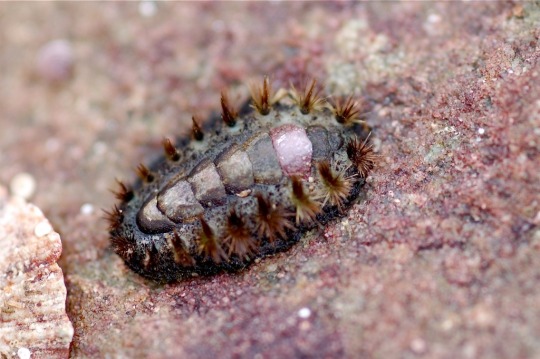
(source)
76 notes
·
View notes
Text
The Bunny
A caption Tale
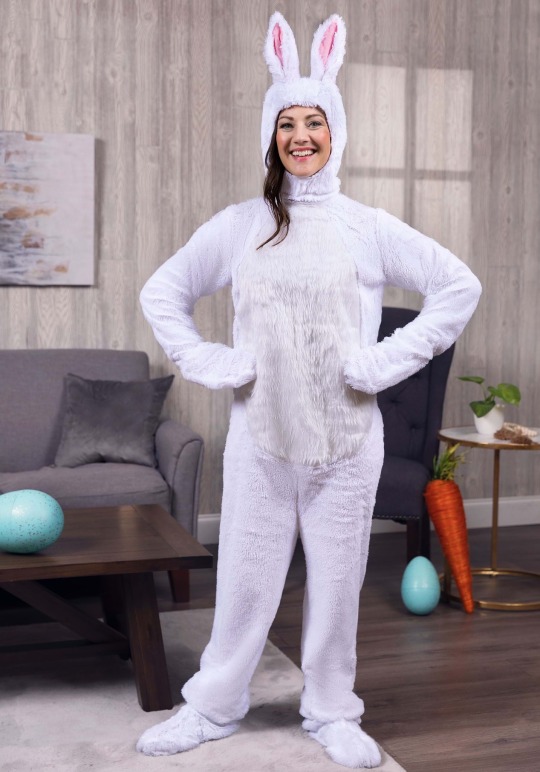
Barbara was smiling as took photos in her bunny costume. “Do you think the kids will like these photos Luke?” She asked her friend and photographer. He looked at her through the camera lens and nodded with a grin. “They're going to love them. You're a natural with those rabbit ears!”
Barbara smiled knowing that her first grade students would get a kick from seeing their teacher dressed as a bunny for Easter. Luke continued to snap photos completely bored. He agreed so quickly when Barbara asked for his assistance with taking photos. He honestly thought Barbara was flirting with him when she said. “I bought a new costume and I need you to take pictures.”
But here he was, lying on the floor with a camera pointed at Barbara, who was frolicking around with the same enthusiasm as a kid in a candy store. He couldn’t help but feel like he was in a sitcom episode. He quickly closed his eyes and imagined her in a different kind of bunny costume.
“Alright, let’s try some action shots!” Barbara exclaimed, hopping towards him. Luke snapped away, trying to keep his focus on the task at hand. Luke aimed his camera as he felt his dreams shoot at her. The flash was like a strobe light in a disco,
capturing Barbara’s laughter and the twirl of her fluffy tail.
Barbara began to feel extremely hot. It was as if the flash poured heat upon her as her bunny costume felt like a sauna. “Hey Luke can I lower my zipper a bit? The suit feels a bit warm.” Luke nodded, trying to keep his cool. The costume was a bit too tight, and Barbara felt like she was suffocating. She reached behind her neck and with a quick zip, the costume loosened, allowing a gust of cool air to hit her skin. The relief was instant.
The heat increased as Luke continued to snap photos. “I feel a bit woozy.” Barbara said as she stumbled trying to find balance on her heels. “Wait… when was I wearing heels?” She looked down to find that she had on black stiletto heels on her feet. The room spun and she reached out for something to hold onto.
Her hand grazed a table and she looked up to see her lips had plumped as her cheekbones became more prominent. The heat became unbearable as she lowered the zipper revealing her enlarging breasts. Barbara looked down to see that under her costume was a tight black leotard. It clung to her body like a second skin, highlighting every curve and contour. She gasped as the reality set in. The bow tie sat rested on her neck. The pink bunny suit fell at her feet. A new pair of black bunny ears sat on her head as her hair became long and luscious.
Her eyes widened and she began to panic, her heart racing as the fabric of the leotard grew tighter and tighter. “What’s happening?” She shrieked. Luke looked up from his camera, his jaw dropping at the transformation. He enjoyed seeing his dreams become reality. The room grew brighter, and Barbara could feel the fabric squeezing her tighter with each flash of the camera. She looked down again and noticed her waist was now cinched in and her hips had widened dramatically.
Luke smiled as he grabbed at his crotch. “Now this is a photo shoot!” Luke continued to take photos as Barbara felt her body move into sensual poses. “What did you do to me?” Barbara asked unable to control her body as every flash of light made her feel warmer.
“It’s all in the camera, baby!” Luke said, his voice deep and hypnotic. Barbara looked into the camera and felt a strange compulsion to obey his every command. She could feel the camera lens caressing her, moving with her every move, capturing every inch of her new form.
“Why does this feel so good?” Barbara thought to herself as she struck pose after pose, her body moving in ways she never knew it could. The leotard was stretching and molding to her new form, accentuating every curve and leaving nothing to the imagination. She felt a strange mix of fear and excitement as she looked down at her new body. Her once plain Jane look had been replaced by the image of a bombshell bunny, and she couldn’t help but feel a rush of power from it.
“Mmm let’s take some photos outside Luke baby.” Barbara’s voice had a new seductive lilt to it. Her eyes were glazed over as she followed the instructions of the camera lens, her body moving in a way that was both mesmerizing and unfamiliar to her. Luke nodded eagerly, his mind racing with the possibilities of the new direction this photoshoot was taking.
“Sure thing Babs!”

#beautification#transformation#f2f transformation#breast expansion#bimboification#ass expansion#beauty is power
131 notes
·
View notes
Video
Bubbling up from the depths by simple.joy Via Flickr: One of my attempts at the "Crazy Tuesday" theme "Abstract". Shot with a "Tomioka-Copal 75 mm F 2.8" (enlarging) lens on a Canon EOS R5.
#Abstract#Crazy Tuesday#Tomioka#Tomioka-Copal 75 mm F 2.8#enlarging lens#enlarger lens#flickr#bubbles#dof#macro
1 note
·
View note
Text
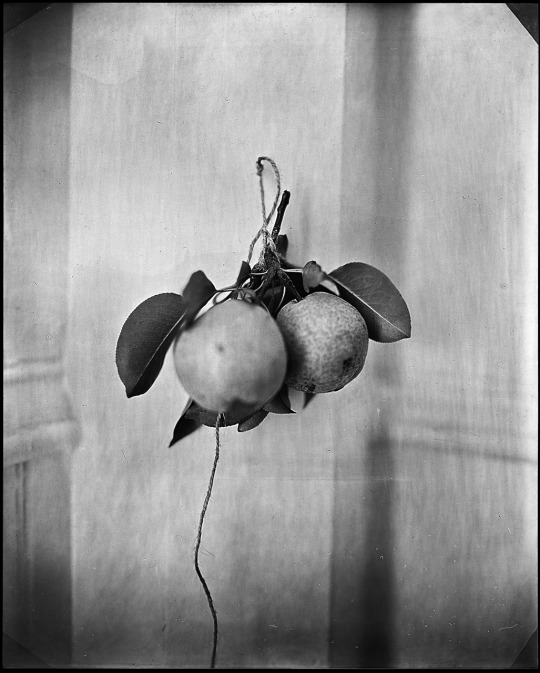
Untitled Large Format Still Life with Pears - analog photograph - paper negative, 8 second exposure +/-, hand-built cardboard box camera, wollensak 127mm enlarger lens, caffenol developer - robert matejcek - 2024
“I want my food dead. Not sick, not dying, dead.” - Oscar Wilde
tags:
#robert matejcek#photography#film photography#analog#paper negative#large format#caffenol#enlarger lens#wollensak#handmade camera#cardboard box camera#alternative photography#alternative photographic processes#experimental#art#my art#still life#artists on tumblr#photographers on tumblr#grunge aesthetic#dark academia
13 notes
·
View notes
Text
Chris and Elias in Platoon (1986). A yap
(Alternatively- The homoerotic relationship between Chris and Elias)
Apologies if this is a little hard to understand, and if the photos are difficult to read
Feel free to comment with your own opinions, ideas or theories on all this
~~~~~~~~~~~~~~~~~~~~~~~~~~~~~~~~~~~~~~~~~~~~~~~~~~~~~~
So one of their earlier notable interactions is when Chris is shot and gets sent to hospital. (Which is not included in the movie) Lerner is there too but all he does is talk about his divorce
First he brings one of Chris’ book that he took when Chris was carrying way too much in the jungle walk (and fainting)
This scene in the movie is one of my favourite, not sure why. Elias basically offers to help him carry his stuff and pretty much makes an invitation for Chris to speak to him again and interact with him.
This is pretty easily readable as platonic, it’s a book, I think it’s a more personal gift though as he specifies it’s a book of Chris’ grandmother’s stories, but it’s never said if Elias knew this.
his other gift was one of Elias’ own purple hearts in a box, there’s a note addressed to Chris that says:
‘Taylor, take a close look at this thing. It's one of mine. Purple Hearts are made out of plastic, but they sure as hell ain't cheap! One is all you'll ever need.”
Again, this could be platonic depending on how you see it. But a war medal is a pretty big thing to gift someone platonically
____________________________________
Now, the underworld scene
First, it states Elias ‘leers’ at Chris. Typically, leering at someone is checking them out.
And after the leer, the shotgun scene commences. Chris thought that Elias wanted to shoot him (phrasing it “Blow him away” which is pretty funny to me)
Then he shotguns from Elias and it describes Chris feeling ‘a warm flush from his head to his armpits’, but I think that’s the weed
____________________________________
Next is one of my other favourite scenes. This is the ‘we’re gonna loose this war’ scene, but the novel has way more detail
So first off Elias grips his shoulders, keep in mind through this they’re both not high (from what I can tell with the context)
Then Chris notes a look in his eyes, describing it as ‘riveting yet demanding’ And ‘softened by a strange supplication’ Which I feel like is a very specific way to describe a man looking at you
[Supplication; the action of asking or begging for something earnestly or humbly.]
[Riveting; completely engrossing; compelling]
So they’re alone together in the middle of the night, and Elias is holding onto him and looking at him with a begging look. Riveting implies it’s compelling to Chris, which I took as Chris wanting to keep staring back.
Im not sure of ‘demanding’ but it feels in the same vain of ‘supplication’. A sort of plea?
Also mentioned is ‘There was an eerie flash in the man's eyes. It was deep .... back beyond the pupils where no one sees but anyone can feel.’
Which is just before the staring and after he grabs his shoulders, a flash of what is never mentioned, but I’m sure it means something
Then, Elias slowly moves his face closer and closer to Chris.
‘Chris froze and watched Elias's face as it moved slowly to within inches of his own. The move had been slow and determined, enlarging to fill his field of vision like a subject seen through a zoom lens.’
Which, is like something out of a romance movie. If Chris was a woman this would’ve been taken way different, when I read it I half expected them to kiss
‘He was reminded of the fierce glare Elias had used to halt Barnes in the ville.’
A fierce glare seems wrong for the situation. like Chris was mistaking some sort of intense stare for the angry glare he gave Barnes. This is backed up by the previous description of his staring, the ‘flash’ and the ‘supplication’
After that Elias says that ‘Maybe a piece of me's in you (Chris) now...’ and lets go of Chris who scoots back a bit. Then he smiles and decides he’ll come back as a deer (This is an important tool we’ll use later on)
Chris nods and ‘touched Elias lightly on the shoulder’ before getting up, but Elias grabs his hand’
It is never mentioned that Elias lets go of his hand
Again, if this was a woman and a man it’d be considered romantic. Chris mentions a shooting star
Then Elias tells him to go to sleep, and that’s the end of the charged scene
—
Now, the end of the book
It’s after the huge final battle, Barnes freaks out and loses it and Chris gets a bomb dropped on him.
He wakes up covered in alot of blood and sees this
‘a buck deer with mossy antlers and a snowy white bib tucked beneath his pointy chin. How could anyone with such soft, liquid eyes dispassionately rule the depths of hell? At the sound of roaring engines and creaking tracks, the deer lifted its ears, twitched its nose and bolted away into the brush. The animal moved with fluid grace, Chris noticed, as Elias had moved before Barnes killed him.’
First off, Chris describes the deer as lucifer. The devil, even though it’s implied to be Elias paying a visit.
Now if you really want to analyse it, I think you could look at it as Chris considering Elias a sin or something along those lines
‘How could anyone with such soft, liquid eyes dispassionately rule the depths of hell?’
Someone, not something like you would with an animal. Or, to me. ‘how could someone like Elias go to hell?’
With the context of the 60s/70s there’s a high chance he grew up religious, and especially being told homosexuality is a sin. But Elias showed up and apparently flipped it, he’s struggling with it. Elias gets killed and he thinks he’ll go to hell for his drug use or something along that line (and maybe his gay vibes idk) but then he thinks, how could someone as amazing as Elias go to an eternal fire pit, be tortured and all that.
It’s well known everyone loves Elias, he’s considered pretty friendly and all that. Not a stereotypical evil sinner
‘he decided the devil truly defied stereotype. Lucifer looked like a buck deer with mossy antlers and a snowy white bib tucked beneath his pointy chin.’
Now, this would seem like a pretty mystical sight. But Chris rejects it and decides that it’s the devil. Again, I’m not sure where I’m going here but it feels like it means something.
Then, the deer bolts. Just like how Elias ran from Barnes’ attack And Chris is rescued by the medical team or something of that sort (can’t remember the exact way they described them, but they help him)
And (a little after that) the movie ends.
Elias is long dead by then so we get nothing. Chris never sees his body or says goodbye to him, just a ‘I move faster alone’ (which, Chris doesn’t want to leave him alone. He wants to go with him, and he’s the one who wants to go back to get him or retrieve his body)
And he kills Barnes in revenge. He’d already fought him over it, he even wants to frag Barnes. Now we all know Barnes is a murderer and war criminal but ‘I’ll fight and eventually kill the much more experienced and stronger man for you’ seems like a lot. He could’ve reported Barnes and taken it through the court martialing (although that might not have worked) but he chose to revenge kill him.
for Elias.
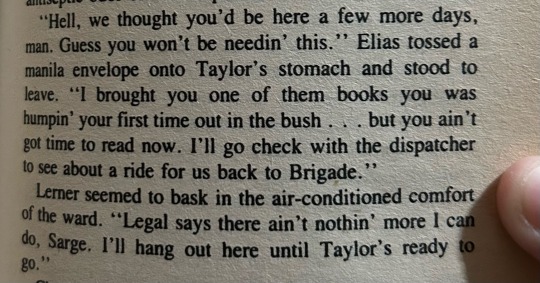
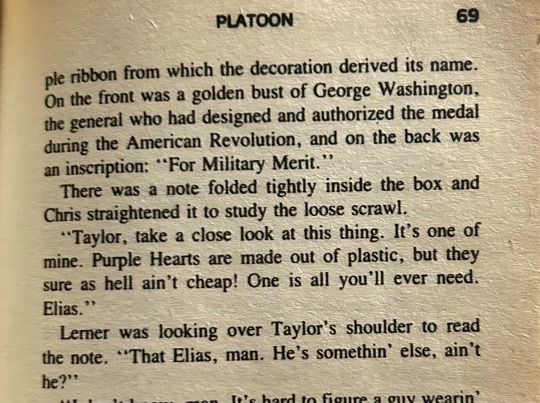
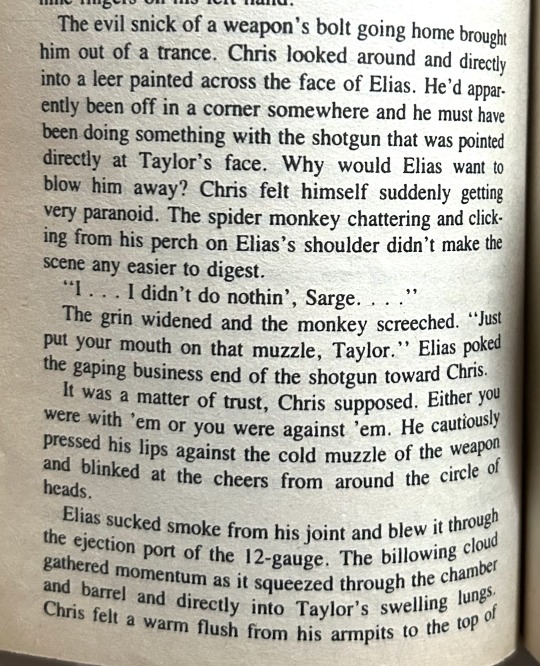
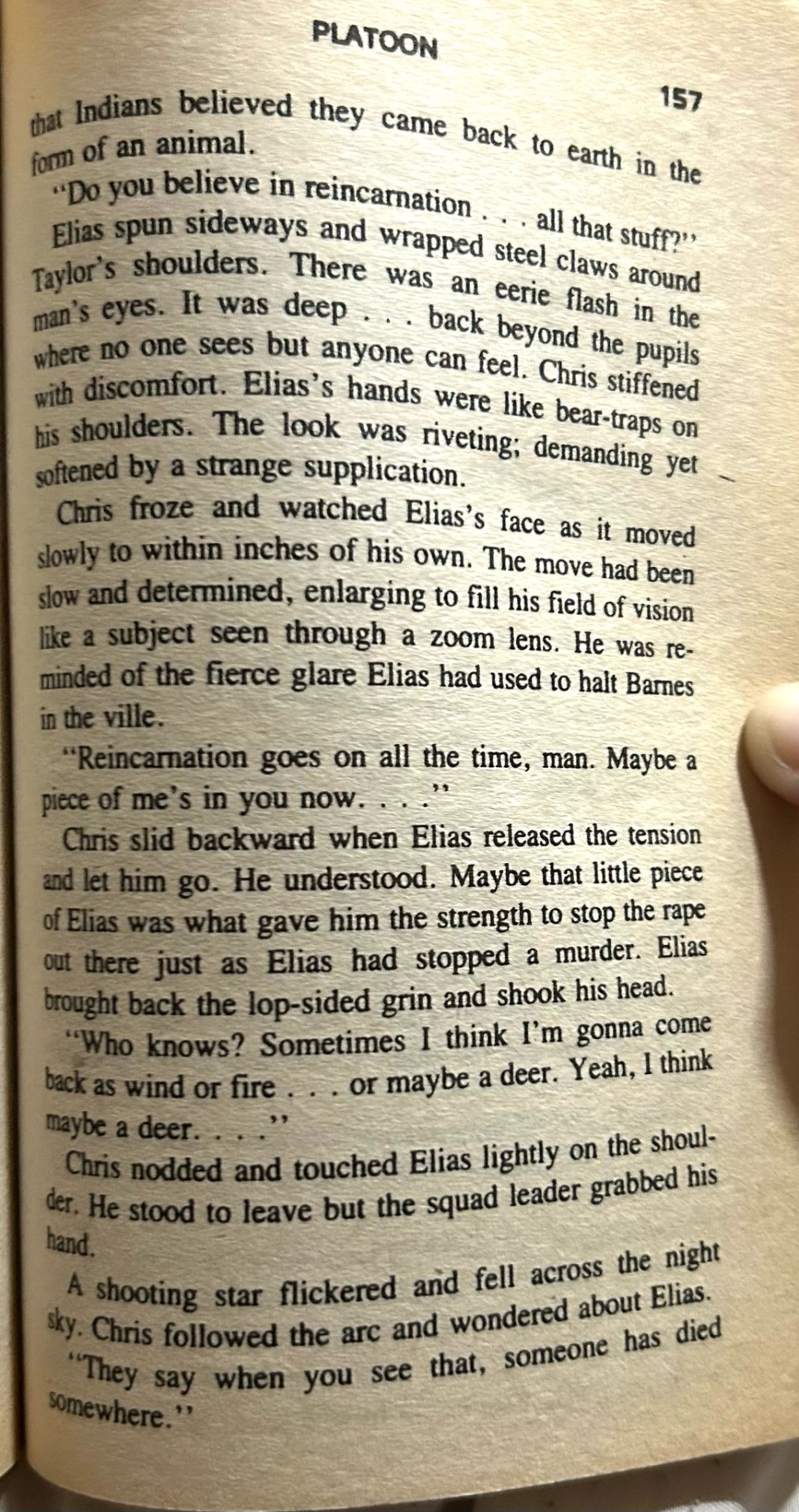

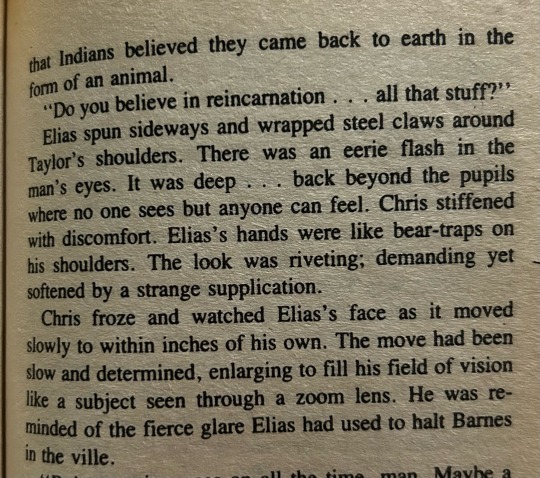
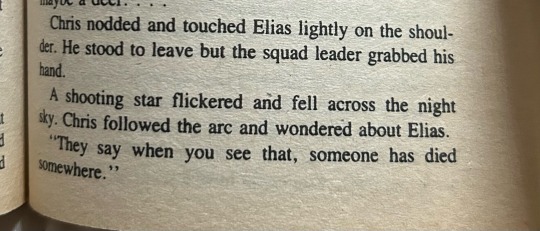
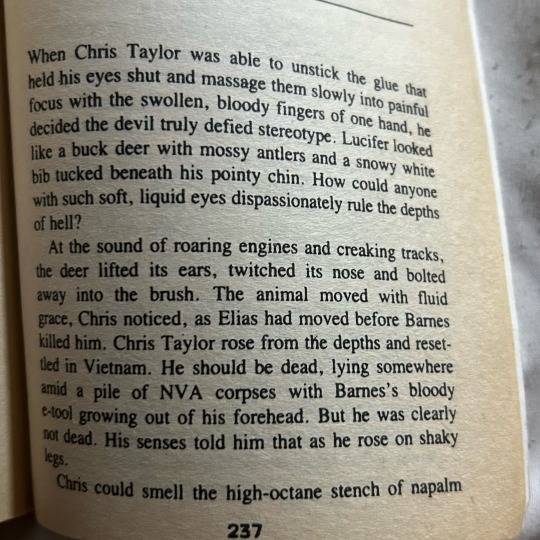
#platoon (1986)#platoon 1986#platoon#sergeant Elias#elias grodin#chris taylor#war movies#they’re gay your honor#rant post#yapping#essay#?#chrilias#chris and elias#willem dafoe#charlie sheen#movies#homoerotism#small fandoms#gay#gay men#lgbtq
15 notes
·
View notes
Note
Tell us about your film setup? 👀
as in my cameras? sure!!!
I guess my "primary" film camera is my canon AE-1. Lenses are expensive so I usually just use a 50mm f/1.4 lens. My grandfather left me his Nikon F that I have yet to actually use but I've been waiting for a good time to walk around with it.
I also have One medium format camera (currently missing ;-;), it's a Yashicaflex TLR that shoots 6x6. I have darkroom chemistry that I use to develop everything myself, really the only thing i'm missing is a good scanning setup and an enlarger!
11 notes
·
View notes
Note
Are you familiar with Jared Polin, aka 'Fro Knows Photo'? I'm not a pro like him, nor do I aspire to be, but I can put his tips into practice, such as putting my money into 'glass glass glass glass glass' with the D600. Thanks to a miserable season, baseball tickets today are dirt cheap. Thanks to KEH, heavy artillery glass was a bargain. Plan on getting action shots with the 80-200mm at f/2.8, 1/2000 sec and letting the camera deal with the ISO. Beauty shots around the park 'f/8 and be there.' Hope you're well today. Let's Go Bucs!
I have mixed feelings about Jared. He can be crass and some of his photography opinions are old school and outdated. Though he has gotten better over the years and I actually enjoy his videos more now than in the past.
My main gripe is that he doesn't believe in cropping photos, which bothers me to no end. The beauty of having high megapixel cameras is the ability to crop in and almost get a "second lens" without having to actually buy one. As a disabled photographer who cannot always "zoom with my feet" sometimes I have to take photos knowing I will be cropping them later on.
The main reason for "not cropping" goes back to film and prints. Your photos would always end up the same size and aspect ratio. Also, 35mm film did not enlarge very well, especially with the low sharpness lenses from the past. That is not a constraint with presenting photos in a digital medium.
I also think he cranks the contrast up on his photos to a ridiculous degree. I want to re-edit all of his photos because anything in shadow gets lost. But that is more of a subjective complaint.
He is a great natural light, documentary style photographer. And I do think his real world testing of gear is a good perspective over some of the other camera reviewers that do nothing but lab tests. (Both have their place.)
In the end, he has a lot of experience and has some pretty stunning photos in his portfolio. And I do like that he isn't afraid of high ISO photography like some others can be. So as long as you ignore his advice about cropping, I do think he has a lot to teach.
If I could recommend one photographer to folks who are in the beginning of their photography journey, I think it would be French-Canadian wildlife photographer, Simon d'Entremont. (pronounced see-mon) Even if you aren't into wildlife shooting, his photography education/communication skills are fantastic. He breaks everything down into very easy-to-understand chunks and makes very few (if any) factual errors. He is a good balance of artistic and technical and gives very practical advice for getting better shots. And his work is absolutely stunning.
I also think you might enjoy Sean Tucker. He tends to be less about gear and more about the art and philosophy of photography.
And you are correct, lenses are far more important than any other piece of gear. They are the main thing that sets big cameras apart from smartphones. You can't break the laws of physics and certain things require more than a tiny plastic lens can do.
Also, I miss baseball. I really enjoyed watching games with my dad when he was sick and had trouble concentrating on shows with a narrative. But it has been hard for me to watch a game since he passed. So I just follow some baseball YouTube channels to dip my toe back into that world every once in a while. I think I just need more time and I will get back into baseball again. Also, the Cardinals seem to be struggling so this was probably a good time to step away.
Though I do feel like I am missing out on seeing Shohei Ohtani's career develop.
17 notes
·
View notes
Text
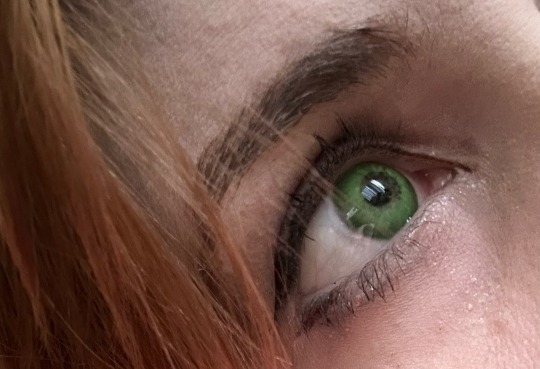
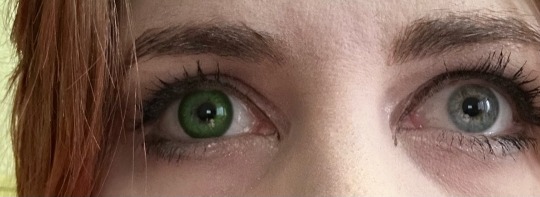
I got some new cosplay lenses and since I can’t find anyone with light eyes using these online anywhere, I thought I’d share! These are Etia Reorv lenses, in Nephrite.
Green does admittedly blend really well with blue eyes, but the pupil hole is pretty small and they blend to being so light near the center that I’d feel confident ordering these in significantly more different colors! They’re also one day disposables and super comfortable. My partner says you can’t even tell they’re color contacts from about five feet away, and even as close as a foot away they just look more saturated than real eyes can. These pictures are 100% unretouched!!
you have to use a shopping service to order Etia lenses since they don’t ship outside Japan, but since I’m pretty regularly proxy ordering from Classe, I don’t have a problem with that. Here’s the link with the full color range if anyone else is interested!
Personally I think I have a new go to cosplay lens for when I want minimal enlargement but gorgeous and bright color!
#cosplay#cosplay contacts#remember kiddies always make sure you CAN wear lenses before you wear cosplay lenses!#something something storming lighteyes
20 notes
·
View notes